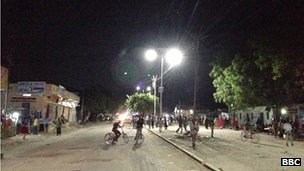Last night I went for a stroll in Mogadishu.
 For twenty-odd years the dusty streets of this infamously dangerous city have emptied in a furious hurry at sunset.
For twenty-odd years the dusty streets of this infamously dangerous city have emptied in a furious hurry at sunset.
In the relentless dark, clan militias or Islamist militants would set up their roadblocks – shadowy figures illuminated by the occasional headlights of an army pick-up. Only the well-armed or the desperate would venture out.
But things are changing in the Somali capital – and in the course of a week spent travelling around the city, nothing I saw illustrates that shift more dramatically than the scenes I witnessed at 8pm.
It wasn’t just a few kids hanging out near a bonfire. Or a family sitting on the steps of their home.
There were crowds – big, happy, chaotic crowds of boys, girls, men and women. I must have seen a dozen football matches on the streets.
One section had been cordoned off with some stones and was being used for driving lessons. At the roadside dozens of shops were open – their doorways flickering with multi-coloured lights.
And the reason for the change?
Streetlights.
Solar-powered, Chinese-manufactured, astonishingly bright streetlights have been erected along two main roads through the city. In all, 15 kilometres (10 miles) have been illuminated courtesy of a project funded by the Norwegian and British governments.
“I feel like I’m making a real difference in people’s lives,” said a smiling Abdi Mahamed Adow, the man in charge of the $400,000 project, as he showed me the start of a dusty, potholed road that gleamed far into the distance with more than a 100 brand new lampposts and their 60 watt LED lights.
After a successful pilot project, the bulk of the poles and lights went up in the course of the last few weeks.
“Now we are planning many more,” said Mr Adow. Responsibility for maintaining the lights and their solar panels will soon be transferred to the city’s administration, which is anxious to impress a population that has had little or no experience of local services or government for a generation.
Rising hopesThe project has come at a time of growing optimism in Mogadishu. Despite enduring poverty, vast numbers of displaced families, corruption, unemployment, an absence of state institutions, and continuing security threats and attacks by the Islamist militants of al-Shabaab, there is a widespread and fiercely held belief that Somalia may finally be on the mend.
That belief was robustly demonstrated to me by the MBA students of the University of Somalia, who were kind enough to invite me into their classroom one afternoon this week.
Although their chancellor was worried about the spread of Islamist ideology – “Al Shabaab-ism” as he called it – by schools and rival universities funded by the Gulf states, the students were emphatic in their conviction that Somalia was enjoying an irreversible revival and that journalists like me should do more to illustrate “the good news.”
Source. BBC News


Leave a Reply